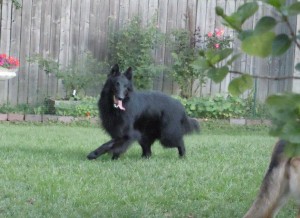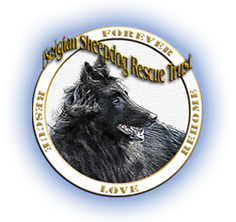The Belgian Sheepdog is an intelligent and loyal companion who requires time, training and socialization and an outlet for his boundless energy. Due to his size, intelligence, vibrant personality and elegant beauty, owning a Belgian Sheepdog is a responsibility not to be taken lightly. When you invest time in training and socialization, your dog will develop into a well-adjusted adult that you will be proud to be seen with in public. To help you provide the best care for your Belgian Sheepdog, we encourage you to participate in the Belgian Sheepdog Club of America , regional special interest clubs, on-line Internet chat lists, and of course in basic obedience.
History
The Belgian Sheepdog, Belgian Tervuren and Belgian Malinois began as three local variations of one breed, which was known as the Belgian Shepherd or Continental Shepherd. The dog that was heir to the name Belgian Sheepdog was originally known as the Groenendael variation of the breed. Like all the Belgian Shepherds, it was a working farm dog expected to both herd and guard. It differed from the others because it had a rather long, black coat. In 1910 these dogs were officially dubbed Groenendael after the kennel that had selectively bred the black dogs since 1893 (just after the Belgian Shepherds were recognized as a breed). By this time, the breed had gained some repute as a police dog and was already employed in this capacity in America. In World War I, they continued to shine as sentry dogs, messengers and even draft dogs. It was here that they captured the attention of the public, and they soon enjoyed a fair amount of popularity after the war. In 1959, the three Belgian Shepherd breeds were divided into separate breeds, with the Groenendael subsequently known as the Belgian Sheepdog. With its shimmering black coat, it is the most striking of the Belgian breeds, and that fact, along with its versatile abilities, has won it many faithful supporters.
Temperament

Belgian Sheepdogs are sensitive, intelligent, high-energy dogs. They are easily trained as long as training is done with gentle handling and without severe physical correction. Most Belgian Sheepdogs are energetic dogs and require vigorous daily exercise to keep them healthy and happy. Running and playing with another dog, retrieving a ball, swimming or participating in other activities, such as formal training exercises or long walks with their owners, are some ways your dog can get the exercise he needs. If adequate exercise is not provided on a daily basis, your dog may bark or become mischievious out of frustration and boredom.
Upkeep
Belgian Sheepdogs are healthy and long-lived dogs and are excellent companions. They are tolerant of respectful children. Due to their herding and working history they are intuitively protective of their people. They are dogs that thrive on human companionship. They have an intense need to be near their owners, following them from room to room when indoors and watching them closely at all times. Because of this trait, your Belgian Sheepdog will be happiest when kept in the house as a member of your family. Dogs kept in kennels or outdoors in fenced yards need a significant amount of “people time” each day in order to remain emotionally healthy. Isolation from humans will quickly ruin a Belgian Sheepdog’s personality and general outlook.
Care and Grooming
Belgian Sheepdogs require a proper diet of quality food and regular medical care with required vaccinations for protection against diseases. Heartworm medication is highly recommended if you live in a heartworm area. A healthy Belgian Sheepdog coat sheds dirt and does not require a great deal of maintenance. Weekly brushing down to the skin with a pin brush will eliminate mats and tangles and remove dander and dust. A slicker brush and undercoat rake will help remove undercoat during the shedding season; which typically occurs twice per year and lasts about a week.
Weekly toenail trimming and teeth cleaning should also be part of your dog’s grooming routine. Owners who have taken proper care of their dogs are usually rewarded with their Belgians Sheepdogs living long active lives. A Belgian Sheepdog living to 12 – 14 or more years of age is not unheard of.
Form and Function
 The Belgian Sheepdog is an elegant, square-proportioned dog that is alert and agile with proud carriage. Its bone is moderately heavy. As a dog expected to herd for long hours; its gait is smooth, tireless and effortless rather than driving. It has a tendency to move in a circle rather than a straight line. Unless under command, Belgian Sheepdogs are constantly in motion. It has an extremely dense undercoat along with an outer coat of abundant guard hairs that are long, well-fitting and straight. Its expression is intelligent, alert, and questioning; its black coloration is striking.
The Belgian Sheepdog is an elegant, square-proportioned dog that is alert and agile with proud carriage. Its bone is moderately heavy. As a dog expected to herd for long hours; its gait is smooth, tireless and effortless rather than driving. It has a tendency to move in a circle rather than a straight line. Unless under command, Belgian Sheepdogs are constantly in motion. It has an extremely dense undercoat along with an outer coat of abundant guard hairs that are long, well-fitting and straight. Its expression is intelligent, alert, and questioning; its black coloration is striking.
Health Concerns
Belgian Sheepdogs are generally a healthy breed but, like all living things, can be susceptible to disease and affected by hereditary issues. In this breed, some problems that are seen are cancer, epilepsy, hip and elbow dysplaysia, PRA and cataracts.. Every breed has health concerns that owners (both new and experienced) need to be aware of in order to make the best decisions about ownership.
Another point to consider is that the health concerns highlighted here are very rarely unmanageable – or result in the death of a pet. Many times, the health concerns referenced are much more of an inconvenience to the owners than they are to the dogs – which learn to compensate quickly.
